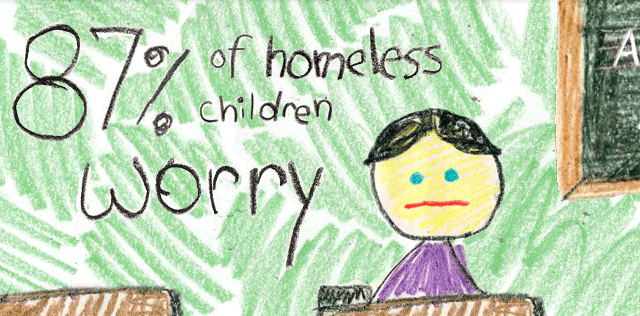
Homelessness in Caricature: How Empathy Can Help Us to Understand Homelessness as both the Result and Cause of Crisis
 Editor’s note: CHN Guest Blogger Thomas Leonetti is a junior at Lake Forest Academy outside Chicago. He’s a Yale Young Global Scholar and Parkour athlete. He is the creator of Aeolus Parkour, an initiative that raises community support for the homeless in Chicago. He is also the creator of Free Tutoring Online, a social enterprise that provides free peer tutoring for students in underserved communities.
Editor’s note: CHN Guest Blogger Thomas Leonetti is a junior at Lake Forest Academy outside Chicago. He’s a Yale Young Global Scholar and Parkour athlete. He is the creator of Aeolus Parkour, an initiative that raises community support for the homeless in Chicago. He is also the creator of Free Tutoring Online, a social enterprise that provides free peer tutoring for students in underserved communities.
In America, when we think of homeless people, we think of a man in tattered clothes, maybe with a sign, standing on a street corner or slumped beside a building. We think of shopping carts and dirty faces, people who sleep under overpasses. It’s amazing to me how cartoon the image is, just short of a cartoon hobo from a century ago with a bandana bundle on a stick. Once I started caring about homelessness as an issue and getting involved in working with the homeless in my community, I became more aware of these stereotypes everywhere from political speeches to crime dramas to my friends’ and classmates’ jokes.
The reality is, there isn’t one stock image of a homeless person, one template that they all follow. These caricatures allow the general American public to feel that homelessness is not their problem, or not a worry they might ever face. They allow otherwise good people to think that homelessness is not in their very communities, affecting their classmates and coworkers, their friends or their children’s friends, and that those relying on social services to stave off homelessness are somehow less-than, using and living off others because of an inability or unwillingness to contribute. Only once we increase our understanding of the causes and effects of homelessness, and increase our empathy for and human connection to individuals in that condition, can we fully understand the essential nature of the social services that help to both prevent and repair homelessness.
There are 325 million people living in America, and over half a million of them are homeless. This number does not include all the people who are living in unsafe housing, or temporary housing, or in other situations that do not give them the safety, security, and comfort that they need to succeed in school, work, and family responsibilities, to stay healthy and safe, and to operate at their full potential. But it does include the 2.5 million children who experience homelessness each year in America.

Graphic Credit: American Institutes for Research – National Center on Family Homelessness.
If those numbers seem irreconcilable, they make sense once one understands that homelessness can be, and often is, temporary. Such a fact may lead lawmakers to believe that it doesn’t need a systemic solution, and it may lead the everyday reader to think of such homelessness as something less than “real.” The National Coalition for the Homeless reports that the average length of time in a homeless shelter “was 69 days for single men, 51 days for single women, and 70 days for families.” It may be easy to conceive of this time, approximately two months, as short. It may be easy to think of a week on the street as short, or a few weeks sleeping in a car as short. But when we truly empathize with individuals that have been in this situation, we can understand that the length of time is neither short nor insignificant.
Even a relatively short period of homelessness is both a symptom of and a cause of crisis. When an individual is homeless, they have lost a safe and stable place to reside. Whether the cause is economic, such as not having the ability to pay rent, or social, such as domestic violence making it unsafe to stay at home, there is an underlying crisis necessary for an individual to become homeless. The state of homelessness itself, compounding the issue, creates a new crisis. Without their own home, safety and security are greatly diminished. Individuals on the street or in shelters are at risk of being attacked or otherwise victimized. Without a safe place to keep possessions, they may lose important belongings or essential records. Without a permanent address, they may lose access to programs that require mail, bank accounts, government benefits, information sent by mail, jobs or job opportunities, or other essential tethers to safety and security in modern life. Without their own home, parents may lose custody of children, parolees may lose their parole, and other freedoms may be taken from individuals. An individual must lose almost everything to become homeless, even for a short time; in becoming homeless, he or she then loses even more of what little is left.
Consider a medical emergency that is both a symptom and a cause of crisis: a heart attack. Someone suffers a heart attack because his or her heart health has deteriorated, whether from another illness, or stress, or lifestyle factors such as diet and exercise. These root causes need to be addressed to stop the heart attack from happening again (or ideally, prevent it in the first place). But the attack itself requires medical treatment, quickly and aggressively, to limit its damage and to give the patient a chance to recover. Homelessness, both a symptom and cause of crisis, is much the same: it needs both long-term preventative solutions and short-term crisis solutions in order to aid in the recovery of those who suffer from its effects.
We are able to dismiss homelessness as a societal issue, in part, because we allow ourselves not to consider the temporarily homeless as part of the caricature of the homeless. The family who has to sleep in their car while they save enough for a new apartment. The woman who stays at a shelter while leaving an abusive spouse. The teen who runs away from home and spends her time between friends’ apartments, living out of a backpack. These people are not the fringes of homelessness, or the exceptions -they are faces of a very real epidemic within the United States. In order to address such an epidemic appropriately, we must treat homelessness as both the symptom and the cause of crises that it is.

Homeless shelters and food banks and similar resources are there to treat the crisis that is caused by homelessness, and they are essential for doing so. But investment in resources to treat the crises that cause homelessness is equally if not more important, in that it can help to avoid homelessness all together, thus saving not only the funds necessary to combat homelessness but the pain and loss incurred by those who suffer from it. When we view the homeless as a caricature, a man living for decades under a bridge, we may feel that preventing homelessness is an insurmountable task. But when we understand that temporary homelessness is a valid part of homelessness, that temporary homelessness is a symptom of an individual or family in a crisis and a cause of additional crises to that individual or family, we can realize that preventing homelessness is not only essential but achievable. Resources such as housing assistance are an obvious attempt at preventing homelessness, but we must understand a broader set of factors in order to realize the value of seemingly unrelated social programs in keeping individuals and families in their homes.
Programs such as free after-school care for young children, free or reduced school lunch, SNAP benefits, and free academic or tax services may be designed to directly combat problems such as hunger or tax compliance, but these programs and others like them contribute to combating homelessness by helping to provide resources for at-risk populations. For many people on the brink of homelessness, these small contributions make the difference between managing their rent or finding themselves homeless. What we must realize is how many people who look nothing like the caricature of homelessness are one emergency away from facing a crisis. Sixty-six million Americans have no savings for an emergency: none. That means roughly twenty percent of Americans faced with a large unexpected expense could face a financial crisis. Over thirty-nine million Americans live in poverty, and a seemingly small expense could be the catalyst that put any of these individuals or families at risk for homelessness. A trip to the hospital, legal fees, an unexpected increase in rent, a bail charge, or a necessary car or home repair could be enough to move someone to homelessness. When we understand that homelessness is a crisis but so is the state of being one emergency away from homelessness, we can understand that all social services that provide a safety net for families in poverty and without savings are essential to decreasing and ultimately preventing homelessness. Readers who are interested in empathizing with this situation or understanding just how quickly it can arise may be interested in exploring “Spent,” an online game created by the Urban Ministries of Durham to demonstrate the crisis nature of poverty that is available at playspent.org. When we can move beyond the caricature of homeless people and understand that they are unique and individual, we can begin to better empathize and understand that just as the onset of homelessness can be caused by a small financial or emotional event, the small financial and emotional investments we as a society make in those in need can be the key to preventing homelessness in the first place.
 In our current political climate in the United States, empathy is often viewed as a weakness. Caricatures are used as a way to divide us and to villainize people who are suffering, with images of “welfare queens” and “welfare Cadillacs” polarizing voters and helping them to view those needing resources as users who are “other” to themselves. As the President and the news media continue to embrace divisive language and to belittle those in need by redefining poverty to make it look as if it has been reduced and characterizing it as a moral failure, we are encouraged not to empathize, but instead to feel that we are better than those who need help, and we should keep what resources we have for ourselves instead of helping those in need. As the economic divide in the U.S. grows greater and wealth shifts disproportionately to an increasingly smaller number of individuals and families, resisting this narrative and maintaining our empathy for others is a key to combating homelessness. And while there are many ways to tap into our empathy for others and more deeply understand issues of homelessness in America, from reading current research to games such as “Spent” mentioned above, perhaps the easiest and most essential is to speak with individuals in our communities who are or have been homeless.
In our current political climate in the United States, empathy is often viewed as a weakness. Caricatures are used as a way to divide us and to villainize people who are suffering, with images of “welfare queens” and “welfare Cadillacs” polarizing voters and helping them to view those needing resources as users who are “other” to themselves. As the President and the news media continue to embrace divisive language and to belittle those in need by redefining poverty to make it look as if it has been reduced and characterizing it as a moral failure, we are encouraged not to empathize, but instead to feel that we are better than those who need help, and we should keep what resources we have for ourselves instead of helping those in need. As the economic divide in the U.S. grows greater and wealth shifts disproportionately to an increasingly smaller number of individuals and families, resisting this narrative and maintaining our empathy for others is a key to combating homelessness. And while there are many ways to tap into our empathy for others and more deeply understand issues of homelessness in America, from reading current research to games such as “Spent” mentioned above, perhaps the easiest and most essential is to speak with individuals in our communities who are or have been homeless.
 When we connect as individuals and learn one another’s lived experiences, we are less able to dismiss the problems that we face. It is essential that we increase the diversity of the people with whom we interact and from who we get information, so that instead of falling into talking points of our current beliefs and falling along increasing divisive lines of thinking, we can instead remember that people who are suffering are individuals with individual circumstances who are, often, just the same as us, and whose situation could often just as easily be our own. It is by building this empathy and removing the villainous nature with which homelessness is often represented that we can more deeply understand the need for the social safety net that helps to prevent homelessness and can continue to support and grow the programs that provide these essential services.
When we connect as individuals and learn one another’s lived experiences, we are less able to dismiss the problems that we face. It is essential that we increase the diversity of the people with whom we interact and from who we get information, so that instead of falling into talking points of our current beliefs and falling along increasing divisive lines of thinking, we can instead remember that people who are suffering are individuals with individual circumstances who are, often, just the same as us, and whose situation could often just as easily be our own. It is by building this empathy and removing the villainous nature with which homelessness is often represented that we can more deeply understand the need for the social safety net that helps to prevent homelessness and can continue to support and grow the programs that provide these essential services.

